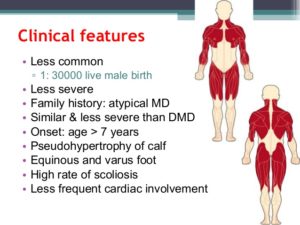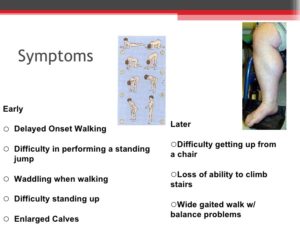Causes
Muscular dystrophy can run in families, or you can be the first one in your family to have it. The condition is caused by problems in your genes.
Genes contain the information your cells need to make proteins that control all of the different functions in the body. When a gene has a problem, your cells can make the wrong protein, the wrong amount of it, or a damaged protein.
You can get muscular dystrophy even if neither of your parents had the disease. This happens when one of your genes gets a defect on its own. But it’s rare for someone to get it this way.
In people with muscular dystrophy, the broken genes are the ones that make the proteins that keep muscles healthy and strong. For example, those with Duchenne or Becker muscular dystrophies make too little of a protein called dystrophin, which strengthens muscles and protects them from injury.
Symptoms
For most types of muscular dystrophy, symptoms start to show up in childhood or in the teen years. In general, children with the condition:
You can get muscular dystrophy even if neither of your parents had the disease. This happens when one of your genes gets a defect on its own. But it’s rare for someone to get it this way.
In people with muscular dystrophy, the broken genes are the ones that make the proteins that keep muscles healthy and strong. For example, those with Duchenne or Becker muscular dystrophies make too little of a protein called dystrophin, which strengthens muscles and protects them from injury. Symptoms include:
- Falling down often
- Have weak muscles
- Have muscle cramps
- Have trouble getting up, climbing stairs, running, or jumping
- Walk on their toes or waddle
Some will also have symptoms like:
- A curved spine (called scoliosis)
- Droopy eyelids
- Heart problems
- Trouble breathing or swallowing
- Vision problems
- Weakness in the muscles of the face
How its diagnosed:
Physical Exam including checking your muscle strengths tested, blood tests, MRI, EMG-electromyography, and even a muscle biopsy.
Treatment: Unfortunately there is no cure but was is used to help deal with the disease is:
- Physical therapy uses different exercises and stretches to keep muscles strong and flexible.
- Occupational therapy teaches your child how to make the most of what his muscles can do. Therapists can also show him how to use wheelchairs, braces, and other devices that can help him with daily life.
- Speech therapy will teach him easier ways to talk if his throat or face muscles are weak.
- Respiratory therapy can help if your child is having trouble breathing. He’ll learn ways to make it easier to breathe, or get machines to help.
- Medicines can help ease symptoms.
- Eteplirsen (Exondys 51) has been approved to treat DMD. It is an injection medication that helps treat individuals with a specific mutation of the gene that leads to DMD. The most common side effects are balance problems and vomiting. Although the drug increases dystrophin production, which would predict improvement in muscle function, this has not yet been shown.
- Anti-seizure drugs reduce muscle spasms.
- Blood pressure medicines help with heart problems.
- Drugs that turn down the body’s immune system, called immunosuppressants, may slow damage to muscle cells.
- Steroids like prednisone slow down muscle damage and can help your child breathe better. They can cause serious side effects, such as weak bones and a higher risk of infections.
- Creatine, a chemical normally found in the body, can help supply energy to muscles and improve strength for some people. Ask your child’s doctor if these supplements are a good idea for him.
- Surgery can help with different complications of muscular dystrophy, like heart problems or trouble swallowing.
Try to include with your Rx from your doctor:

